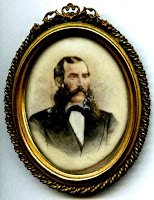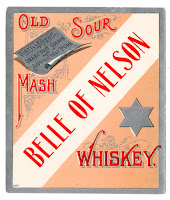 Although William Bartley, shown here, is not numbered among the major figures of Kentucky distilling, often referred to as “Barons,” his Belle of Nelson whiskey generated what arguably can be considered the most iconic advertisement of the pre-Prohibition era. Some 138 years after it first appeared the image today can be purchased in multiple formats from multiple sources.
Although William Bartley, shown here, is not numbered among the major figures of Kentucky distilling, often referred to as “Barons,” his Belle of Nelson whiskey generated what arguably can be considered the most iconic advertisement of the pre-Prohibition era. Some 138 years after it first appeared the image today can be purchased in multiple formats from multiple sources.
Shown below, the picture allegedly offered a view inside the harem of a wealthy sheikh inhabited by a number of light skinned, well endowed women who are perfectly nude. Two are lounging in the foreground while a servant woman of color offers them hookah pipes. The half moon label advertises “Belle of Nelson, Old Fashioned Hand Made Sour Mash Whiskey.” and below, “Distilled by the Belle of Nelson Distillery Co., Louisville.”
 Sources indicates that Bartley ordered this ad from the Wells & Hope Company of Philadelphia. Located at 918-922 Vine Street, this printing firm was established by John F. Hope and Joseph Lewis Wells in 1845. Their company, one that hired a cohort of anonymous artists, was known for production of lithographs in paper and metal signs, glass, and mirror advertisements. Distilleries and breweries were among frequent customers.
Sources indicates that Bartley ordered this ad from the Wells & Hope Company of Philadelphia. Located at 918-922 Vine Street, this printing firm was established by John F. Hope and Joseph Lewis Wells in 1845. Their company, one that hired a cohort of anonymous artists, was known for production of lithographs in paper and metal signs, glass, and mirror advertisements. Distilleries and breweries were among frequent customers.
Indications are that Bartley first used the harem scene ad in October 1882, about one year after he had purchased the rights to the name “Belle of Nelson” from the Mattingly & Moore Company. That distillery, at least temporarily, had suffered financial reverses that caused it to declare bankruptcy for its distillery located outside Bardstown, Kentucky.. Bartley, located in Louisville, subsequently moved the operation about 54 miles south of that city to New Hope, Nelson County, Kentucky. The site was on the South Fork of Pottinger Creek about two miles from the Marion County Line. There on eight acres Bartley built a large new distillery on eight acres, shown below.
Insurance underwriter records note that the distillery was frame construction with a metal or slate roof. There were three warehouses and an annex: Warehouse A was iron clad with a metal or slate roof located 327 feet west of the still house. This was a free (non-bonded) warehouse situated on a hilltop. Warehouse B was iron clad with a metal or slate roof located 160 feet south of the still house. It also was on a hilltop. Warehouse C was iron clad with a metal or slate roof sited 260 feet from the still house. The annex building also was iron clad with a metal or slate roof 210 feet southwest of the still house. Slops from the mashing process were fed to cattle, housed in a nearby frame barn. The Belle of Nelson Distillery was a major Kentucky whiskey-making facility.
 But who was William Bartley? Not from one of the Kentucky dynastic distillery families, he was born in August 1813 in Edinburgh, Scotland. His parents are unidentified. When he was 18 years old, Bartley immigrated to the United States, landing in New York but soon settling in Kentucky. Early on he was engaged as a dealer in cotton and other commodities. One reference suggests liquor was among them. From a whiskey-making region of Scotland, Bartley may have had some experience in that trade.
But who was William Bartley? Not from one of the Kentucky dynastic distillery families, he was born in August 1813 in Edinburgh, Scotland. His parents are unidentified. When he was 18 years old, Bartley immigrated to the United States, landing in New York but soon settling in Kentucky. Early on he was engaged as a dealer in cotton and other commodities. One reference suggests liquor was among them. From a whiskey-making region of Scotland, Bartley may have had some experience in that trade.
 The Scotsman also was also engaged in family life. Several years after his arrival in Kentucky he met a local woman three years his elder. She was Hannah M. Downing, born in Cork, Ireland. They married circa 1838 and immediately began having children. Shown here is a Bartley family photo, taken about 1845. From left the children are Nora, William, Jr., and John. A fourth child, Hannah, would be born in 1847. Bartley’s intense gaze is intriguing.
The Scotsman also was also engaged in family life. Several years after his arrival in Kentucky he met a local woman three years his elder. She was Hannah M. Downing, born in Cork, Ireland. They married circa 1838 and immediately began having children. Shown here is a Bartley family photo, taken about 1845. From left the children are Nora, William, Jr., and John. A fourth child, Hannah, would be born in 1847. Bartley’s intense gaze is intriguing.
Perhaps he was thinking about another love. In September 1855, Bartley is recorded marrying Emily Mathusa Milford in Louisville. Unlike immigrant Hannah, Emily was from an elite Southern family, said to be connected by birth or marriage with many old Southern families of Mississippi and Louisiana. Her father, Col. Henry Johnson, was a wealthy plantation owner who divided his time between Louisville and his Mississippi properties.
Although both bride and groom had previous marriages and their earlier spouses were still living, no mention is made in the record of divorces, although they can be assumed. William now 50, and Emily, 40, would go on to have four children of their own, Emily, Margaret, William T. and David. Bartley’s daughter Nora later married Henry Milford, Emily’s son by her earlier marriage. As a result, Nora’s step-mother also became her mother-in-law. Things could get complicated in 19th Century Kentucky.
 Fast forward to 1895. Thirteen years after its founding, “Louisville of Today” featured the Belle of Nelson distillery in an article. The publication painted a picture of almost immediate success: “…No sooner were the goods of the company put on the market than they met with great favor, Time has only served to strengthen this popularity and today their various brands find ready sales in all parts of the United States.”
Fast forward to 1895. Thirteen years after its founding, “Louisville of Today” featured the Belle of Nelson distillery in an article. The publication painted a picture of almost immediate success: “…No sooner were the goods of the company put on the market than they met with great favor, Time has only served to strengthen this popularity and today their various brands find ready sales in all parts of the United States.”
The article went on to claim: “The distillery is splendidly constructed and is, in equipment, a perfect model of up-to-date convenience and completeness. Machines and appliances of the most approved devices are provided throughout and the distilling capacity is seven hundreds bushels a day.” Warehouse storage capacity was set at 20,000 barrels and employment said to be thirty distillery workers and eight traveling salesmen.
 The Belle of Nelson brand was widely advertised, extolled for being “…distilled in the hills of Nelson County from the finest of Golden Rye-malt and Maize and Mountain Spring Water.” At $15.00 for a two gallon case it was relatively expensive whiskey. Orders, ads claimed, could be filled from distillery “depots” in ten American cities located from coast to coast. Belle of Nelson provided wholesale customers like bars and saloons with fancy “label under glass” back of the bar bottles and retail customers with trade cards. Shown below is a card that recently went up for auction at $250.
The Belle of Nelson brand was widely advertised, extolled for being “…distilled in the hills of Nelson County from the finest of Golden Rye-malt and Maize and Mountain Spring Water.” At $15.00 for a two gallon case it was relatively expensive whiskey. Orders, ads claimed, could be filled from distillery “depots” in ten American cities located from coast to coast. Belle of Nelson provided wholesale customers like bars and saloons with fancy “label under glass” back of the bar bottles and retail customers with trade cards. Shown below is a card that recently went up for auction at $250.
Diagnosed with a diseased heart, William Bartley died on July 16, 1885, at the age of 72. He was buried in Louisville’s Cave Hill Cemetery where many of Kentucky’s whiskey “barons” are interred. Emily at 73 joined him there 11 years later. Their adjoining gravestones are shown below.
After Bartley’s death, his distillery holdings apparently came under the control of Emily who appointed two sons from her first marriage to run the Belle of Nelson Distillery. The president was Robert J. Tilford and the general manager C. M. Tilford. David, her son by Brantley, was appointed secretary-treasurer. By the late 1890s, the Tilfords were gone and David seems to have been guiding the operation. He declared bankruptcy in 1899 and the distillery was sold to the Whiskey Trust in 1900.
The Trust in turn assigned the facility to allied distillers Stoll & Company. [See post April 23, 2017]. The Stolls took over the New Hope distillery and brand name, continuing to produce Belle of Nelson Whiskey. In keeping with the precedent set by William Brantley for advertising with colorful saloon posters, the Stolls issued the two signs shown below. National Prohibition brought an end to the brand, even as Brantley’s racy harem image has been perpetuated down though the years.
Note: This post was constructed from multiple sources. The most important of them were the 1895 publication, “Louisville of Today,” issued by the Consolidated Illustrating Company of Louisville and “The Evolution of the Bourbon Whiskey Industry in Kentucky” by Sam K. Cecil.











%20C_pg875_BROADWAY_A-%20CND_29TH_STREET,_SHOWING_IMPERIAL_MUSIC_HALL_AND_DALY'S_THEATRE.jpg)






























